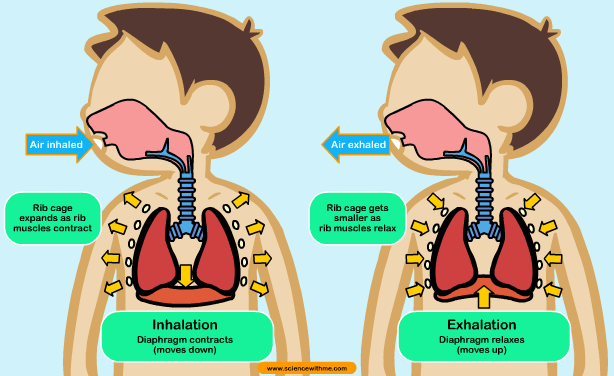Like other vertebrates, you rely on a large amount of energy made available through the metabolism of food and oxygen.
Humans and many other organisms are called “aerobic” organisms because they need oxygen in order to survive.
What is respiration?
Respiration is the term used to refer to the movement of oxygen into your body and tissues and the movement of carbon dioxide from your body to the environment. Different organisms have different modes of respiration and respiratory systems.

What is the basis of respiration?
The basis of respiration or gas exchange is called a pressure gradient. Remember that substances tend to move from an area of higher concentration to an area of lower concentration. This is also called diffusion. This is true for the two gases essential for respiration—oxygen and carbon dioxide. Since oxygen concentration is greater in the external environment, it tends to go inside your body through your respiratory system. Since the carbon dioxide concentration becomes highly concentrated in your body, as a result of metabolic processes, it tends to go outside your body.
What factors affect respiration?
There are three main factors that affect respiration. The first is surface-to-volume ratio. The second is ventilation and the third is the presence of transport pigments.
-
Surface-volume ratio: Respiration is more efficient when there is higher surface-to-volume ratio. This is the reason why your lungs have alveoli, which increase the surface area through which oxygen and carbon dioxide can diffuse through.
-
Ventilation: Larger animals have larger body volumes. Therefore, they need a process other than diffusion in order to have enough oxygen and eliminate enough carbon dioxide. This process is called ventilation. You ventilate your lungs when you breathe in and out. In fish, ventilation is provided by their gills, which move back and forth. This stirs the surrounding water, thereby bringing more dissolved oxygen to the fish and more carbon dioxide away from the gills.
-
Transport pigments: Increased exchange of oxygen and carbon dioxide is made possible by transport pigments. In humans, the main transport pigment is hemoglobin.
 In your alveoli, the oxygen concentration is high and the hemoglobin molecule binds a maximum of four oxygen molecules. Hemoglobin combined with oxygen molecules is called oxyhemoglobin. Our blood animation depicts this nicely and helps kids understand the science behind what is happening in our bodies. Your circulatory system then brings oxyhemoglobin to your other tissues. In the tissues, oxygen follows its pressure gradient. It leaves the hemoglobin molecule and diffuses into your tissues. Alternatively, once near the tissues, hemoglobin also binds with carbon dioxide. This hemoglobin is called carboxyhemoglobin or carbaminohemoglobin. Additionally, carbon dioxide becomes dissolved in the blood. The carbon dioxide is then transported back to the lungs, through the action of your circulatory system.
In your alveoli, the oxygen concentration is high and the hemoglobin molecule binds a maximum of four oxygen molecules. Hemoglobin combined with oxygen molecules is called oxyhemoglobin. Our blood animation depicts this nicely and helps kids understand the science behind what is happening in our bodies. Your circulatory system then brings oxyhemoglobin to your other tissues. In the tissues, oxygen follows its pressure gradient. It leaves the hemoglobin molecule and diffuses into your tissues. Alternatively, once near the tissues, hemoglobin also binds with carbon dioxide. This hemoglobin is called carboxyhemoglobin or carbaminohemoglobin. Additionally, carbon dioxide becomes dissolved in the blood. The carbon dioxide is then transported back to the lungs, through the action of your circulatory system.
How do invertebrates undergo respiration?
Invertebrates include earthworms, flatworms and sponges. Most of these organisms do not have specialized respiratory systems because respiration occurs through integumentary exchange. This means that gases simply diffuse directly through their body covering or integument. Integumentary exchange occurs best in moist environments, which is the reason why many invertebrates live in water or aquatic habitats. Other invertebrates like mollusks have gills, which are specialized thin-walled organs for respiration. These gills have folded walls, which increase the surface-to-volume ratio, thereby increasing the gas exchange between the organism and the environment. Also considered invertebrates, insects undergo tracheal respiration. This means that insects have internal respiratory surfaces. These internal respiratory surfaces look like book pages, which earned them the name “book lungs". Internal respiration is important because insects live in a relatively dry environment, compared to other invertebrates.
How do vertebrates undergo respiration?
Many fish have gills but some fish, all amphibians, reptiles, birds and mammals have lungs. The development of lungs in higher vertebrates is an important adaptation for the dry terrestrial environment. Compared to gills and the respiratory systems of invertebrates, lungs provide a larger surface-to-volume ratio.
What controls respiration in humans?
You do not consciously control your breathing so what does it? The answer is in your hindrain. Your respiratory center is present in the medulla oblongata, although the pons and the other centers help regulate your breathing. Neurons in your medulla signal to your respiratory muscles when to inhale and exhale. The control of respiration depends on the concentrations of oxygen, carbon dioxide and hydrogen ions in your blood. When there is too much carbon dioxide, too much hydrogen ions or too little oxygen, your respiratory rate increases in order to enhance elimination of these substances. Respiration is essential to life. To learn about human respiration further be sure and watch out Lord Glucose animation.
